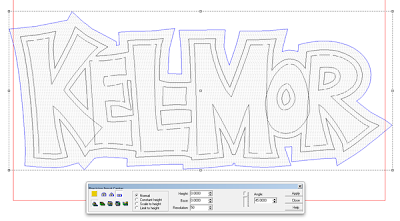I forgot to grab screen captures of the small bottom oval but it was a flat relief, modified with a second layer using the dome tool. Then the 'Q' was added to the top of that with a 0.15" height. It was then merged highest with the previous base relief.
Now we are on to the QUEENS lettering. I built the lettering outline as a separate relief. This would be nudged up or down as necessary in the front view at a later point to make sure it was in proper position in relation to the rest of the sign.
The letter outline relief was then modified by adding beveled letters.
Then I nudged the QUEENS relief vertically until I was happy and merged highest with the background relief.
For the upper crown I took my design cues from the lower lettering and the 'qQ' oval. It would look best arched upwards in the middle. To do this I first created a flat relief and then drew an oval vector around it. I would use this vector to modify the crown outline relief in an arc. I nudged it up a tad in the front view to make it look good in relation to the rest of the sign.
Then I modified the crown outline relief by adding the crown. relief
I checked everything with a render and by looking at the front views and then MERGED it highest with the background relief. The pub sign was looking pretty fine! Not much further to go.
The last step was the PLATE lettering and outline Once again to make things easier to adjust as needed I would build it as a separate relief, starting with the lettering outline, then modifying the outline with the letter shapes and lastly with the top decorations - all at 0.15" tall.
Then I merged highest with the background reliefs one last time.
With that the sign was ready for tool pathing and routing.
-dan























































